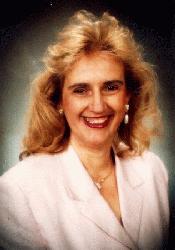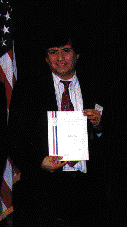
 
A Decade of CRPC Education/Outreach |
|

Cynthia Lanius, CRPC Associate Director  Richard Tapia with his Presidential Award for Excellence in Science, Mathematics, and Engineering Mentoring. For the past decade, the CRPC's Education/Outreach Program has focused on training and encouraging new generations of scientists and engineers that represent the full spectrum and diversity of our population, from kindergarten through adult education. CRPC education programs across the nation have introduced teachers to the exciting possibilities of using computers in the classroom, encouraged middle- and high-school students to enter computer science-related fields, and inspired college students to pursue graduate studies involving scientific problem-solving in numerous technological areas. CRPC Director of Education and Human Resources Richard Tapia provided the programs' vision and leadership. A Rice University Noah Harding Professor of Computational and Applied Mathematics, Tapia received a National Science Foundation (NSF) 1996 Presidential Award for Excellence in Science, Mathematics, and Engineering Mentoring; the 1997 American Association for the Advancement of Science (AAAS) Lifetime Mentor Award; the 1999 Quality Education for Minorities Mathematics, Science, and Engineering (QEM/MSE) Network Giants in Science Award, and other prestigious national awards in recognition of his efforts to bring underrepresented minorities and women into computational engineering-related fields. "Beginning with only a handful of devoted CRPC faculty, staff, and students, our outreach program has trained and encouraged thousands of students and teachers in math, science, and computer science education and careers," says Tapia. "Those students and teachers have in turn impacted thousands more throughout our communities. The full story is not only in the quantity and diversity of the students, but in the quality of life-building experiences they have gained." Although the CRPC is ending this year, some of its programs will continue under different funding, and all will have a long-lasting impact on the lives of the participants and those they teach and mentor. (See "CRPC Tributes" for comments from students and teachers who have participated in CRPC programs.) Following are brief descriptions of the education/outreach programs initiated and supported by the CRPC since its founding in 1989. Computers: The Machines, Science, People and Careers! Held annually at the California Institute of Technology (Caltech), this two-day program offered more than 100 minority high school students a stimulating first-hand exposure to problems and issues in computer science. The event served to demystify scientific research and to give students new insights into career opportunities awaiting them in science, engineering, and mathematics. The Caltech Center for Advanced Computing Research (CACR) will administer and Intel Corporation will fund this event in the future. Minorities Teachers Computational Sciences and Graphics Awareness Program High school teachers from schools with large minority enrollments in Los Angeles and Pasadena, California, attended an annual five-day session at Caltech to learn about the most recent developments and opportunities in the areas of concurrent computing and graphics. The teachers used this information to motivate their students to consider career opportunities in science and engineering. The program has concluded. Summer Research Programs in Computing for Women and Minorities Caltech offered two summer programs for undergraduate women and minorities, in which students in computer science and mathematics spent two to three months working on research projects with Caltech scientists. The students were intimately involved in leading-edge computational research using parallel computers. Stimulated by this environment, many participants continued their education through graduate school. The program has concluded. Expanding Your Horizons in Math and Science Conferences The CRPC at Rice University provided participant financial support and presenters for this annual conference, organized by the West Harris County Branch of the American Association of University Women. Hundreds of middle-school girls and their teachers attended math and science workshops each year, which were presented by women who specialize in these fields. The program continues without CRPC support. Girl Games Project CRPC researchers at Rice University worked with Girl Games, Inc. to develop interactive software that appeals to girls. In an initial exploratory study, 30 secondary school girls rated existing games and expressed their preferences. Based on the findings, small teams of girls worked with multimedia specialists to develop software to fill their needs and address their interests. This project has concluded. GirlTECH This program teaches K-12 mathematics, science, and computer literacy teachers how to effectively incorporate computer technology into the classroom. During intensive training sessions, teachers also learn how to encourage more young women to pursue careers in mathematics and science. GirlTECH will continue with support from RGK Foundation and the NSF's Education, Outreach, and Training Partnerships for Advanced Computational Infrastructure (EOT-PACI). Mathematical and Computational Sciences Awareness Workshop Offered at Rice University and later combined with the GirlTECH program, this annual five-day workshop gave K-12 mathematics and science teachers, principals, and counselors an understanding of the current issues in mathematics and computational science. Rice faculty members, scientists, and industrial participants associated with the CRPC discussed research areas, the job market, and minority issues. Retooling the Supercomputing Community for Scalable Parallelism This project was a National Science Foundation Metacenter Regional Alliance program designed to provide professional trainers at the supercomputer sites with up-to-date curricular materials and training in the use of parallel programming tools and methods. Available electronically, this information was disseminated at supercomputer training courses and workshops nationwide. The program has concluded. The South-Central Computational Science in Minority Institutions Consortium (SC-COSMIC) With roots in Argonne National Laboratory initiatives, SC-COSMIC was formally established by the CRPC and the University of Houston-Downtown to create a virtual electronic educational community among students, faculty, administrators, researchers, and industrial associates. The project promotes state-of-the-art science and math education, enables distance learning, shares research, and provides access to online resources. SC-COSMIC will continue under an NSF Visiting Scientist Grant and two grants from NCSA. Spend a Summer with a Scientist (SaS) This Rice University Program provided opportunities for talented undergraduate and graduate students to participate in university research, motivating them to attend or continue graduate school in science, mathematics, or engineering. Many SaS students also acted as mentors in other CRPC programs for younger students. The program was phased out in 1999 to make way for a similar, but expanded program, the Rice University's Diversity Graduate Program in Science and Engineering (DGPSE). The Rice School/La Escuela Rice Developed by the Houston Independent School District and Rice University, with the assistance of the CRPC, this model K-8 school features a curriculum that emphasizes dual-language development, technology, accelerated education programs, and collaborative learning in small clusters. The school houses approximately 1,200 students and 70 teachers. Research Experiences for Undergraduates At Syracuse University, the CRPC offered talented students research opportunities in high-performance computing. Students worked closely with staff researchers and faculty at the CRPC and Syracuse University, learning project formulation, methodology, solution, and interpretation of results. The program has been discontinued. The Syracuse University Living Schoolbook Project The Northeast Parallel Architectures Center (NPAC) is involved in the Living Schoolbook Project, a program developed in conjunction with the School of Education at Syracuse University to integrate state-of-the-art computerized educational resources into K-12 curricula. The Living Schoolbook creates a unique learning environment that enables teachers and students to use educational resources on multimedia information servers, supercomputers, parallel databases, and network testbeds. Kids Web, an Internet directory for children that presents information targeted at the K-12 level, is part of the Living Schoolbook Project. In addition to these programs, the CRPC designed and implemented new academic programs in parallel computing, including computational science and engineering programs for graduate students, at sites across the nation. Syracuse researchers have pioneered new courses and certification programs in computer science over the Web, including a 10-week course delivered to students at the Harbin Institute of Technology in China. Syracuse also collaborated with Jackson State University to teach computational science courses using the TANGO Interactive collaboratory system. All course materials are on-line, and lectures are given twice a week in real time over the Internet. Caltech developed a problem-solving environment for airshed modeling that enables teachers and students to use parallel computing to study air pollution patterns in the South Coast Air Basin of California. All CRPC sites have fostered the publication and dissemination of educational materials and software on an ongoing basis. In 1997, CRPC Education/Outreach members became involved with the EOT-PACI Program. Richard Tapia is the national co-leader of the effort as well as leader of the Access and Inclusion Team. This effort is aimed at increasing the participation of women, underrepresented minorities, and people with disabilities in high-performance computing and communications careers. The team's programs are targeting students, teachers, administrators, academic and industrial mentors, and policymakers at local, state, and national levels to ensure that the viewpoints and talents of diverse groups will help shape the future of computational research. Co-led by Geoffrey Fox of Syracuse University, the EOT-PACI's Learning Technologies Team is exploring ways in which many of the new technologies originating in PACI partner efforts can enhance learning in all stages of life. The team is focusing on the classroom, particularly on developing self-paced, interactive tools for science and engineering. Prototype programs that are being expanded upon include educational programs that link computational scientists with teachers to develop innovative curricula, web-based textbooks, and tools for visualization, simulation, remote instrumentation, and collaboration. "The CRPC has shown that sharing knowledge and resources can greatly benefit society as a whole," says Tapia. "Our consortium of universities and laboratories has set the pace that universities must maintain into the 21st century. It is critical for our country to strengthen its educational programs, technological position, and economic and social health into the next century and beyond." For more information about CRPC Education/Outreach programs, see www.crpc.rice.edu/CRPC/education/ or contact Theresa Chatman at tlc@rice.edu . |
|
 Other Issues of
PCR Other Issues of
PCR |  Back to PCR Back to PCR |  CRPC Home Page CRPC Home Page |